From Egos to Ecosystems: Rethinking the Creative Process
Blog post description.
Michael Wienke
9/24/20253 min read


From Egos to Ecosystems: Rethinking the Creative Process
We’ve told ourselves the same story about creativity for decades: someone has a flash of insight, the lightbulb flicks on, and a breakthrough is born. It’s tidy. Romantic. Easy to package in a keynote slide.
But it’s also incomplete.
Creativity isn’t a single person’s lightning strike. It’s a slow burn that depends on the environment around it. If brainstorming was about getting egos in a room, the future has to be about building ecosystems where ideas can actually live.
The Old Story: Geniuses at Work
The classic models of creativity gave us four neat stages: preparation, incubation, illumination, verification. Problem, pause, spark, solution. Simple enough to sketch on a napkin.
And like brainstorming, it felt good. Who doesn’t like the idea of sudden brilliance? It made creativity seem like magic, as if one person could hold the answer the whole time.
But real work rarely fits those lines. Ideas don’t appear fully formed. They stutter, double back, and evolve in conversation. The lone genius isn’t so alone after all. Even “Eureka” moments usually trace back to hours of debate, false starts, and someone else’s offhand comment.
The Reality: Ideas Live in Systems
Research makes the point clearly: creativity flourishes or falters based on climate. Autonomy, support, resources, and psychological safety aren’t extras. They’re the air ideas breathe.
Without that air, even the best sparks die out. A bold proposal gets buried under process. A fragile insight never leaves the notebook. The system decides what survives.
I’ve seen talented teams shrink back, not because they lacked ideas, but because they learned how quickly new ones could get shut down. After a while, they stop offering them. The soil turns barren.
When Egos Get in the Way
And yet we still design for the ego. The loudest person in the room claims the whiteboard. The leader waits for their idea to be blessed first, which quietly signals what’s “safe.” Teams spend more energy navigating personalities than building on possibilities.
It’s not malicious. It’s structural. We reward confidence over curiosity. Presentations over collaboration. Credit-hoarding over credit-sharing.
The more that happens, the smaller the ecosystem becomes. Ideas that don’t fit the reigning ego’s vision never get sunlight.
A Different Lens
What if instead of asking, who’s the genius here, we asked, what’s the ecosystem we’ve built around them?
Do people feel safe offering half-formed thoughts?
Are leaders clearing roadblocks or piling them higher?
Does the culture reward iteration, or punish anything less than perfection?
Those questions matter more than whether a single person is “brilliant.” A healthy ecosystem makes room for brilliance to surface from unexpected places.
What Ecosystems Look Like
Healthy ecosystems aren’t glamorous. They’re often messy. There’s disagreement, failure, and a willingness to keep going anyway.
They show up in small, practical ways:
A meeting where the junior voice gets as much airtime as the senior one.
A leader who protects time for experimentation instead of cramming the calendar with status updates.
A team that views a failed prototype as learning, not wasted effort.
That’s what creative ecosystems look like. Not ping-pong tables. Not branded “innovation labs.” Just conditions where ideas can collide and grow.
Why the Shift Matters
The old models gave us language for creativity. They taught us to see the spark. But if we stay trapped in them, we’ll keep expecting lightbulbs where we need soil, water, and time.
The shift from egos to ecosystems isn’t just semantics. It’s a reframing of responsibility. Creativity stops being a heroic act and starts being a shared duty. Leaders design the conditions. Teams nurture the climate. Individuals contribute sparks, knowing the system won’t snuff them out at the first sign of discomfort.
Because when the environment is right, ideas don’t need heroes. They don’t need someone to carry them alone. They just need room to breathe.
Closing the Gap
If the past was about celebrating the genius at the front of the room, the future has to be about building ecosystems that outlast any single voice. That means rethinking not just how we generate ideas, but how we choose, support, and carry them forward.
From egos to ecosystems isn’t just a catchy phrase. It’s the difference between filling walls with sticky notes that never see daylight and creating cultures where ideas actually become something real.
Because creativity doesn’t die for lack of sparks. It dies when the ecosystem around it forgets to keep them alive.
Enjoy what you just read?


If you enjoyed this, then you'll love the rest of Alex is Dead. Download the complete book today in PDF or EPUB.
Connect
Stay updated with our latest news.
Follow
Join our mailing list
info@alexisdead.com
314-596-2486
© 2025. All rights reserved.